After more research, I found out that CRM software generally falls into three main types: operational, analytical, and collaborative CRMs. Each one brings its own strengths, so knowing the differences can really help you zero in on the best-fit CRM for your business. I’ll break down how different types of CRMs work, plus explore popular CRM examples.
Table of Contents
Types of CRM
- Operational CRMs: Designed to simplify and streamline processes.
- Analytical CRMs: Designed to gather and analyze customer data.
- Collaborative CRMs: Designed to combine marketing, sales, and service data.
Depending on your business structure and goals, one type of CRM will address your needs better than the others.
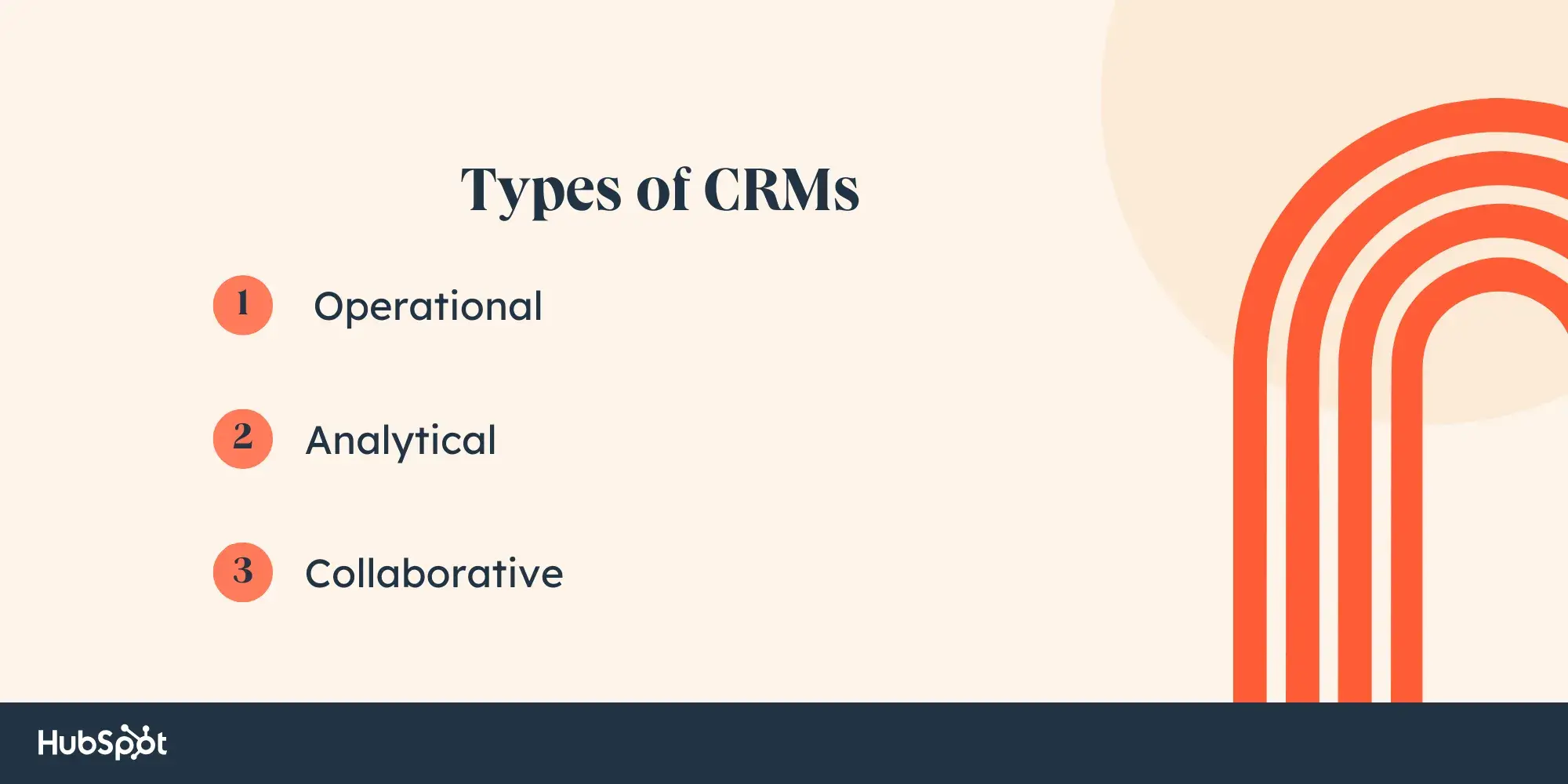
Let’s explore the differences in detail between the three types of CRMs on the market — and why you might choose one over another.
Operational CRM
An operational CRM streamlines and simplifies an organization’s main business processes. In doing so, the tool can help companies generate leads, convert those leads into contacts, and provide the service infrastructure necessary to delight and retain customers.
From my experience, an effective CRM can transform the way a business operates day-to-day offering the following three key functions.
1. Marketing Automation
Operational CRMs make marketers’ lives easier, offering marketing automation features for tedious tasks like email campaigns, content offers, and scaled outreach. You’ll appreciate not having to manually manage these processes, freeing up time for creativity and strategy.
Key Benefits
- Efficiency. CRMs handle time-consuming tasks like email scheduling and follow-ups, helping teams focus on higher-impact activities.
- Data insights. Many CRMs offer analytics on ad performance and lead behavior, which makes tracking ROI more accurate and decision-making more informed.
- Specialized tools. Some CRMs support SEO, blogging, and other niche practices, enabling a more comprehensive approach to marketing.
2. Sales Automation
Sales automation smooths out the entire sales process. Instead of spending time on repetitive administrative tasks, my sales reps can focus on connecting with leads and closing deals.
Key Benefits
- Streamlined communication. CRMs allow scheduling emails for leads, managing meetings, and tracking calls with ease so that no lead is left waiting.
- Automated workflows. With sales automation, reps can rotate leads, delegate contacts, and set up deals without the manual hassle.
- Better lead management. Features like sales record creation, lead prioritization, and deal tracking keep sales reps focused on what matters.
3. Service Automation
Service automation is all about creating an extraordinary experience for customers. It’s the final piece in the CRM puzzle, fostering loyalty and encouraging brand advocacy.
Key Benefits
- Seamless customer support. Service automation establishes 1:1 correspondence between reps and customers, typically via email, live chats, or chatbots.
- Organized ticketing system. A well-implemented ticketing system helps reps tackle each task effectively. Additional features such as a knowledge base or FAQ pages are also commonly associated with service automation.
- Personalized customer interactions. A unified CRM system also pulls in sales record details, giving service reps the info they need to adjust their approach based on each prospect’s unique background. They can also use data from past interactions.
Who should use an operational CRM?
In my opinion, businesses with straightforward sales processes — especially SMBs — will benefit the most from operational CRMs. Even enterprise companies aiming to automate administrative tasks and maintain customer records across multiple departments can consider using one.
Operational CRM System Example: HubSpot
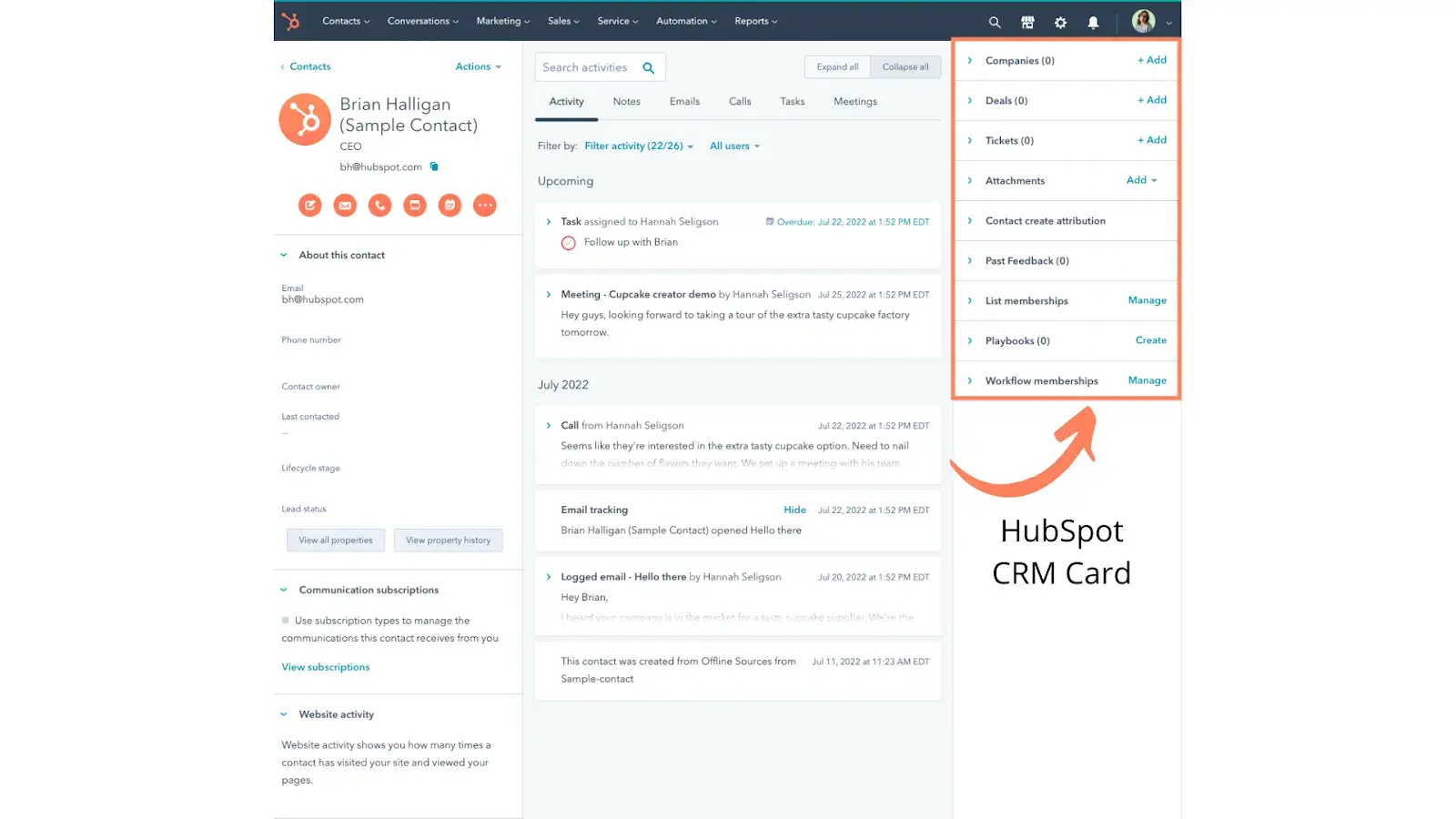
HubSpot is an all-in-one CRM platform meant to align internal teams, pull meaningful insights, and report on growth opportunities. It brings together Marketing Hub, Sales Hub, Service Hub, and CMS Hub, with hundreds of integrations to facilitate marketing, sales, and service processes.
Best for: Any scaling businesses, from SMB to enterprise, and any team, including marketing, sales, customer service, operations, or C-suite.
Key features: HubSpot CRM offers everything in one place to help your team make the most of process automation and system integration. Try it for free to see how it fits your business.
Price: Free forever; plus additional paid plans starting at $15/month.
Why I Like It
I’ve personally tested HubSpot, and here’s why I think it’s a game-changer:
It automates manual tasks (data entry, data sync, and contact data updates) and helps you create an experience and buyer’s journey that your customers will love by centering your entire business around your customers.
Moreover, HubSpot is easy to use and syncs all interactions your team has with leads and customers to that individual’s timeline to maintain organized and accurate contact records for all of your internal team members to access and reference.
Analytical CRM
Analytical CRMs rely on data gathering and analysis to help companies better serve their customers — some examples of this information are customer preferences, behaviors, and contact information.
Leveraging this data, I can improve my sales efforts, execute targeted marketing campaigns, and personalize customer support. In my opinion, the most important components of an analytical CRM are data warehousing, data mining, and OLAP tools.
I’ll walk you through how each of these components works and why I think they’re useful.
1. Data Warehousing
Data warehousing is like having a supercharged database within your CRM. I’ve seen it transform how companies work with customer data, storing both current and historical information in one accessible place. It makes extracting data for analysis so much easier than with traditional databases, which can often be clunky.
Key Benefits
- Unified data source. You get all your customer data in one place, which streamlines analysis and decision-making.
- Easy access to historical data. Need to compare customer trends over the years? It’s right there at your fingertips.
- Enhanced accuracy. With integrated data sources, you reduce errors and improve the reliability of your insights.
2. Data Mining
Data mining is one of my favorite features in an analytical CRM. It’s a catch-all term for the process of discovering patterns in large data sets. I’ve found this especially helpful for understanding the entire customer lifecycle, from identifying and attracting new clients to keeping them loyal.
Key Benefits
- Deep customer insights. You get to understand why your customers behave the way they do.
- Predictive power. It’s amazing how data mining can help you predict customer needs before they’re even on your radar.
- Precise targeting. With a clear view of customer interests, you can craft marketing and sales efforts that resonate.
3. OLAP Tools
Online Analytical Processing (OLAP) tools take things to another level by allowing you to evaluate multidimensional data from multiple perspectives.
I think this is one of the most powerful tools an analytical CRM can offer, especially if you’re looking to understand how different factors affect customer behavior. For instance, you might want to see how people interact with your site based on where they’re located, the time of day they visit, and the features they use.
For me, OLAP tools are what really set an analytical CRM apart because they validate hypotheses formed by the data gathered through data warehousing and data mining.
Key Benefits
- Multidimensional analysis. You can analyze various factors together, like region and usage patterns, for a richer view.
- Deep customer insights. This kind of analysis uncovers more complex trends across different customer segments.
- Enhanced strategic decision-making. With these insights, you can build targeted outreach and marketing plans that are based on solid data.
Who should use an analytical CRM?
I believe analytical CRMs are best suited for businesses that want to make data-driven decisions a core part of their strategy. If you’re ready to dig into some technical software and dedicate time to learn it, this could be a smart choice. It’s not overly complicated, but there’s definitely a learning curve, so having a data-savvy person on your team helps.
Analytical CRM System Example: Zoho Analytics
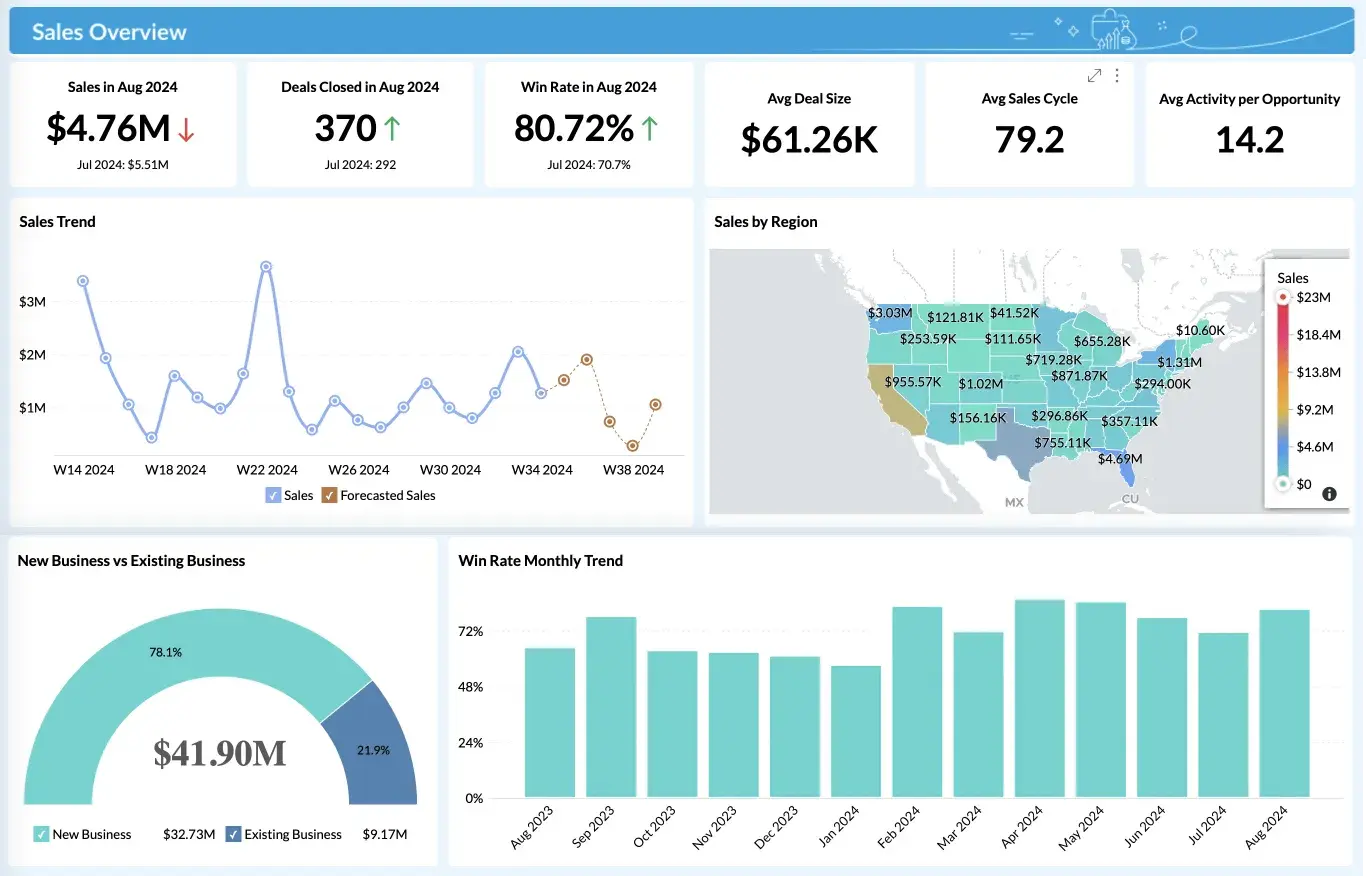
One analytical CRM I’d recommend checking out is Zoho Analytics. I recently had the chance to explore it in a demo, and I was impressed by its real-time analytics capabilities. Zoho Analytics takes raw data and transforms it into actionable dashboards and reports, which can really help with tracking important KPIs.
Best for: Businesses looking to improve their data analysis and reporting capabilities.
Key features: Zoho is all about delivering real-time data to your CRM dashboard so your team can make better decisions right now and drive long-term sales and marketing strategies.
Price: Basic - $24/month; Standard - $48/month; Premium - $115/month; Enterprise - $455/month; Custom plans available.
Collaborative CRM
A collaborative CRM brings together a company’s marketing, sales, and service data to improve synchronicity within the business and give each department a better understanding of their customers’ needs, wants, and interests.
A collaborative CRM has two key components — interaction management and channel management.
1. Interaction Management
Interaction management is essentially the process of tracking every customer interaction — whether it’s through email, social media, face-to-face, or phone. I think of it as a central logbook where team members can update interaction histories and even share insights from their customer conversations.
This centralization means every business unit can access and add to the same record, ensuring consistent customer experiences.
Key Benefits
- Holistic view of customer interactions. Every team can see a complete timeline of customer interactions, which means better coordination.
- Seamless handoffs. When a customer moves from one department to another, the receiving team has all the necessary background.
- Proactive customer service. With full visibility, teams can anticipate customer needs and step in to address issues before they escalate.
2. Channel Management
Channel management takes the information gathered during interaction management and uses it to tailor how you connect with customers. It helps me identify the best channels to communicate with each customer and find the right approach for each team. For instance, if my customer service data shows that customers respond faster on chat than email, it makes sense to prioritize chat for my support team.
Key Benefits
- Targeted communication. By using preferred channels, you can increase response rates and customer satisfaction.
- Resource allocation. Understanding which channels work best helps ensure you’re allocating time and resources efficiently.
- Improved customer relationships. Tailoring communication to customer preferences builds rapport and trust.
Who should use a collaborative CRM?
I’ve found that collaborative CRMs are best suited for businesses with multiple locations, remote teams, or departments that depend heavily on cross-departmental communication. If you value transparency and shared knowledge, a collaborative CRM will be a good fit for your team.
It goes without saying, but a collaborative CRM won’t be a good fit for any company not comfortable with customer information being shared liberally throughout the organization.
Collaborative CRM System Example: Copper
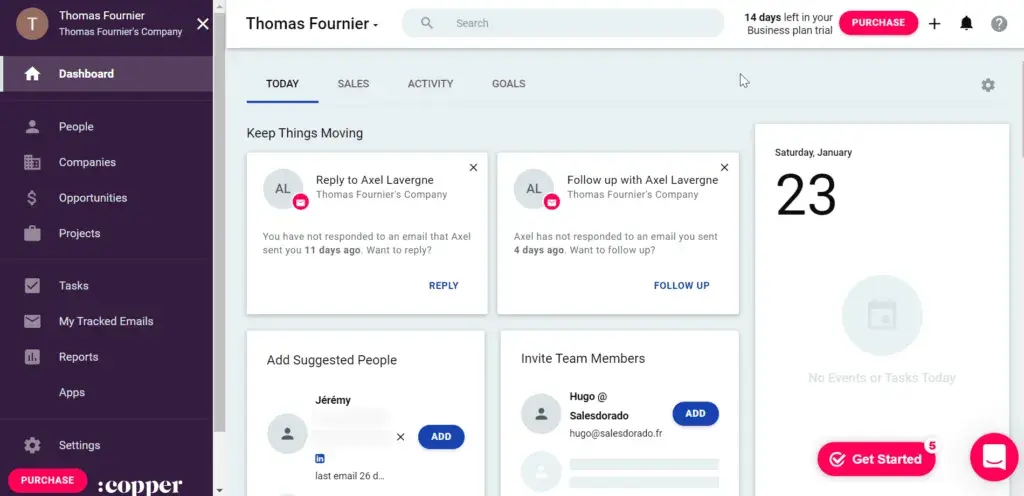
With Copper, all your customer data is stored in one place, allowing everyone across your organization to be in the loop about any customer interaction or deal. The platform’s user-friendly interface also features custom pipelines and dashboards. Copper is a good choice for small businesses looking for a simple, straightforward CRM that integrates seamlessly with Google Workspace.
Best for: Small businesses that place an emphasis on collaboration and are interested in a CRM with a user-friendly interface.
Key features: Copper offers a simple and straightforward way to store and share customer data across your organization. Integration with Google Workspace is also a plus to streamline operations.
Price: Starter - $9/seat/month; Basic - $23/seat/month; Professional - $59/seat/month; Business - $99/seat/month.
Operational, analytical, or collaborative CRM?
I was pleasantly surprised by just how varied CRM solutions can be — each one tailored to meet different business needs. Learning about the differences between operational, analytical, and collaborative CRMs helped me realize just how important it is to align my CRM choice with my business goals — whether it’s improving workflows, digging into data, or boosting team collaboration.
For businesses that want a bit of everything, I think an all-in-one platform like HubSpot’s Customer Platform is a great pick. It brings together analytics, automation, and multi-channel communication in one system, offering the flexibility to tackle multiple needs. It’s a powerful option if you’re looking to boost customer engagement and drive growth.
Editor's note: This post was originally published in December, 2019 and has been updated for comprehensiveness.


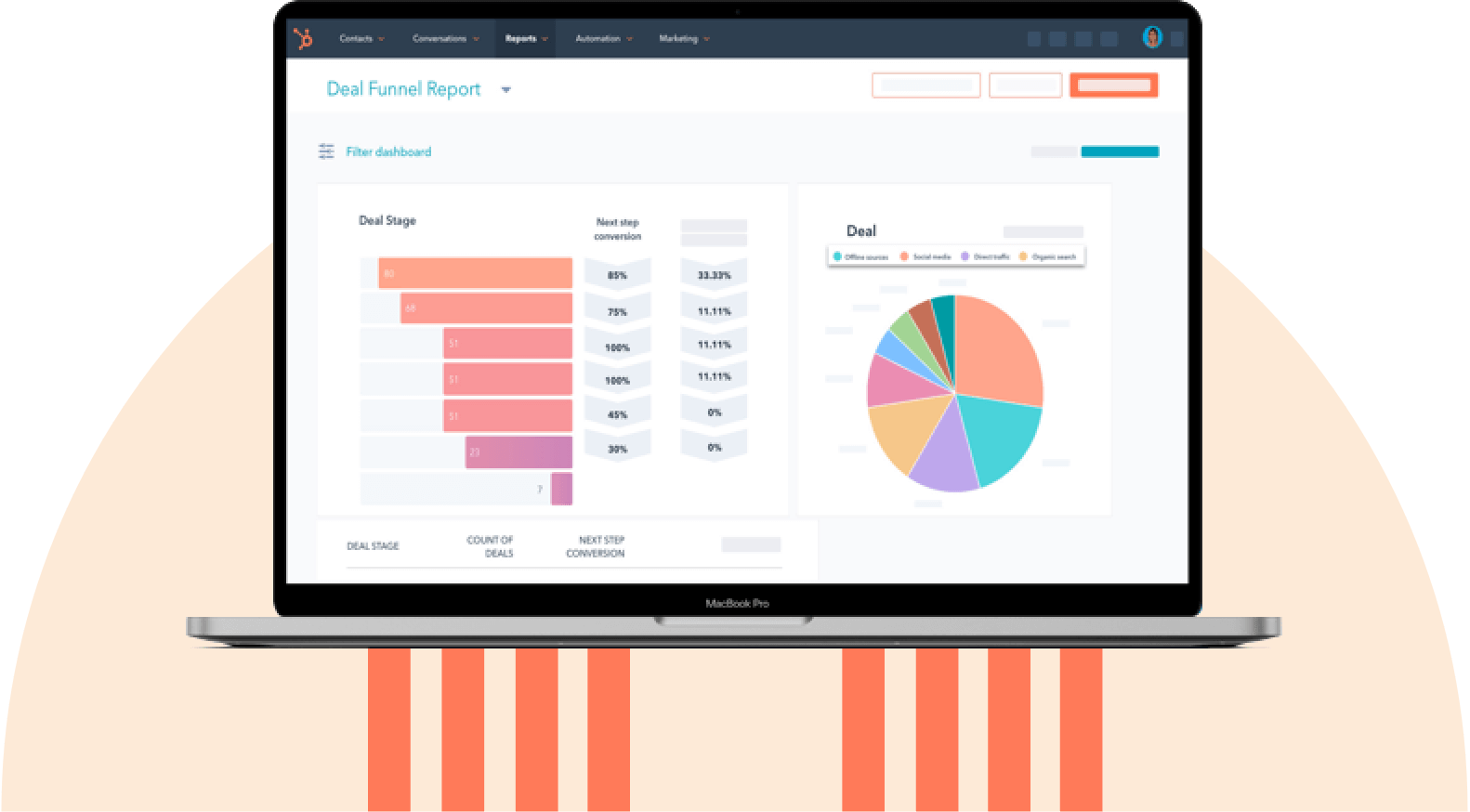









.png)